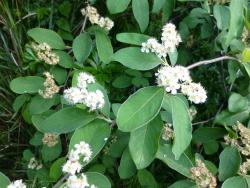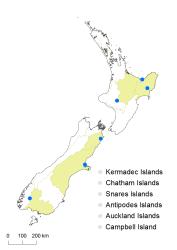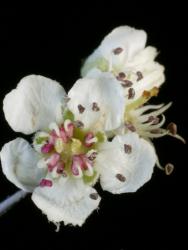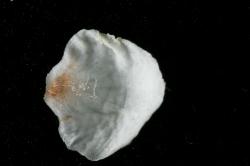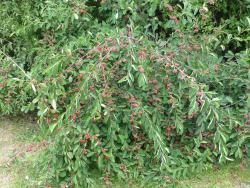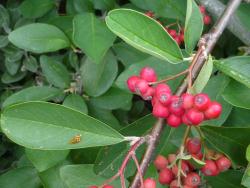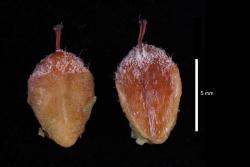Erect shrub to small tree, 2–5 m tall, deciduous to almost deciduous. Branches arching; branchlets grey-brown to red-brown, lenticels sparse, cuticle peeling, branchlet hairs dense, yellow, becoming sparse in autumn; stipule red, 3.0–6.5 mm long, hairs dense, yellow. Leaves crowded on branches, 78–117 mm long, lamina 71–114 mm long, 30–75 mm wide, ovate to elliptic, (220–280 µm), petiole 3–11 mm long, dense, yellow or white, persistent, leaf base cuneate, leaf apex acute to obtuse, apiculus straight; lateral veins in 7–10(12) pairs, midvein only, or also rarely base of lateral veins, impressed above and projecting below; upper surface slightly and very finely rugose, moderate yellowish-green (RHS 139B), dull with waxy bloom that rubs off, upper surface hairs sparse on young leaves, none on old leaves; margins plane, hairs dense white hairs on young leaves, absent from old leaves; lower surface glaucous (may not appear so late in season), hairs dense on young leaves, sparse on old leaves or confined to midvein, white or very pale yellow, fine and crinkled.
Inflorescence a compound corymb of 22–51 flowers, 58–200 mm long, rachis hairs moderately dense, yellow; pedicel 0.5–5.0 mm long, hairs dense, white or yellow, persistent. Flowers 8.0–10.0 mm diameter. Hypanthium green, sepals 1.0 mm long, 2.0–2.8 mm wide, hairs dense, white. Petals spreading, pale green to white in bud, white when open, 3.2–4.0 mm long, 2.2–4.0 mm wide, base slightly clawed, a tuft of hairs, a few hairs present near the base or glabrous, petal margins irregular but not torn. Stamens 18–20; filaments 2.3–4.0 mm long, white; anthers dark purple, 0.6–1.0 mm long; styles invariably 2, 2.0–2.5 mm long. Fruit vivid red (RHS 45A) or vivid reddish-orange (RHS 34A), often the colour varying over the fruit surface, slightly obovate to spherical, 7.0–9.2 mm long, 6.6–9.0 mm diameter, calyx closed or calyx lobes abscising, hairs dense on young fruit, later confined to calyx lobes and base of fruit. Pyrenes 2 [very rarely 2(3)], pyrenes sometimes fused, 4.0–6.8 mm long, 3.3–4.6 mm wide, hairs dense at apex, slightly umbonate, style attached 0.4–0.9 mm below pyrene apex or at apex.
An erect tree. Leaves large (lamina 78–117 mm long, 30–75 mm wide), soft in texture, not leathery. Upper leaf surface dull and smooth. Hairs on upper surface confined to the midvein. Marginal hairs dense in young leaves, sparse to absent in old leaves. Lower leaf surface glaucous, hairs on lower surface dense, cottony in young leaves, becoming sparse on old leaves. Flowers in compound corymbs. Petals white, spreading, without a tuft of hairs. Filaments white, anthers dark purple. Style and pyrene number invariably 2. Pyrenes slightly umbonate, with style usually below apex but sometimes at apex. Hair on upper free part of pyrene dense. Fruit globose, hairs dense but rubbing off at maturity.
Most similar to Cotoneaster salicifolius in size and shape of the leaves and size of the plants. Cotoneaster frigidus has leaves that are soft in texture (thin and pliable, not stiff and leathery), the margins are not recurved, the leaves are smooth and dull on the upper leaf surface, while C. salicifolius has leathery, glossy, moderately rugose leaves that are often slightly recurved on the margins. Cotoneaster frigidus almost invariably has 2 pyrenes per fruit and the style is usually attached below the pyrene apex, while C. salicifolius has an equal mixture of 2 and 3 pyrenes per fruit, and the style is always attached at the pyrene apex.
Gisborne (near Eastwoodhill Arboretum, 1989, Ōpōtiki, 1975), Volcanic Plateau (Raetihi, 2016), Christchurch (Victoria Park, 1996). Uncommon in cultivation.
CHR 370871, M. Heginbotham, Nov. 1975, Woodlands, Ōpōtiki. "Roadside".
Flowering: mid-October to December; Fruiting: February to May, not persisting over winter
Diploid (Fryer & Hylmö 2009), confirmed by flow cytometry of CHR 635025 and CHR 638091.



